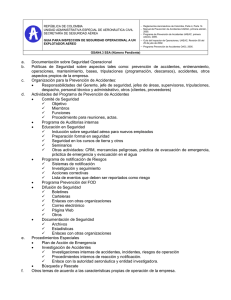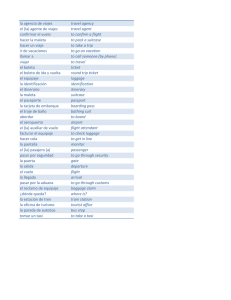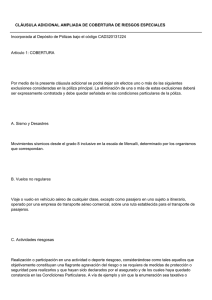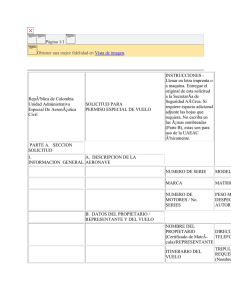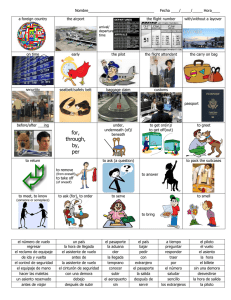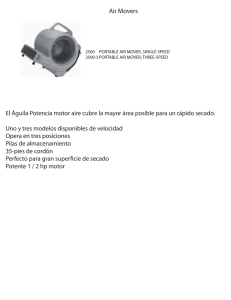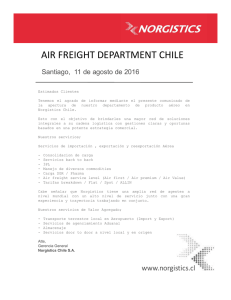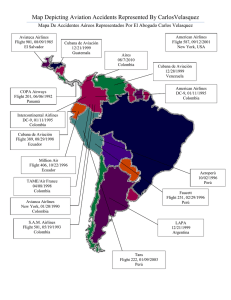A08 - RNAV Visual Flight Procedures
Anuncio
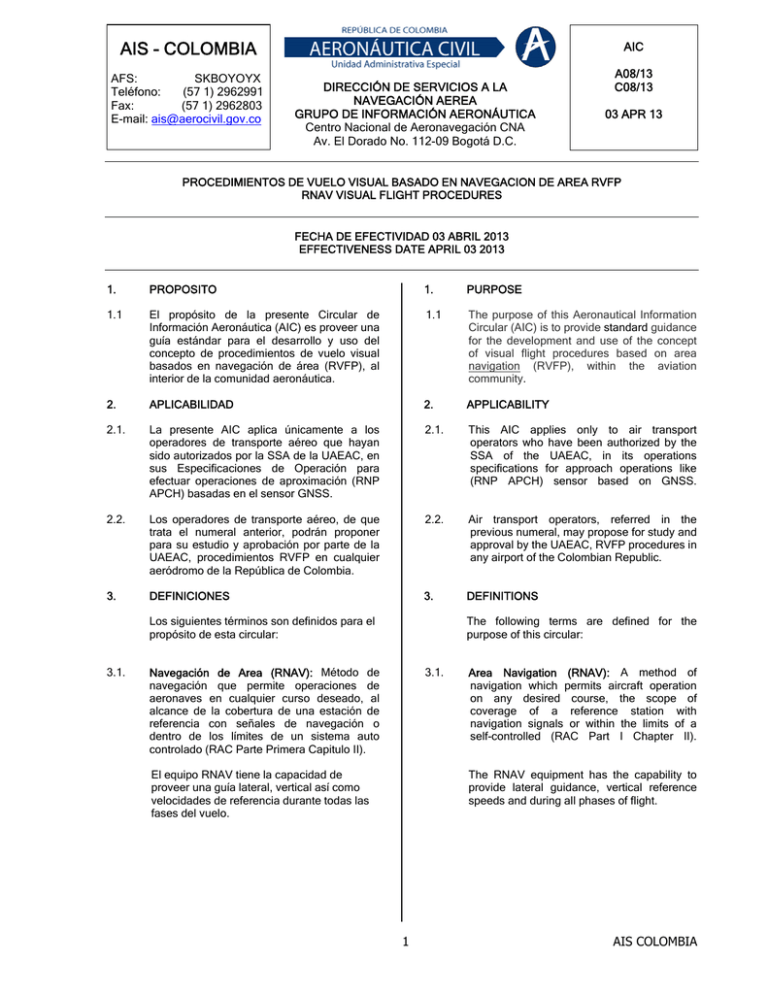
AIS - COLOMBIA AFS: SKBOYOYX Teléfono: (57 1) 2962991 Fax: (57 1) 2962803 E-mail: [email protected] AIC DIRECCIÓN DE SERVICIOS A LA NAVEGACIÓN AEREA GRUPO DE INFORMACIÓN AERONÁUTICA Centro Nacional de Aeronavegación CNA Av. El Dorado No. 112-09 Bogotá D.C. A08/13 C08/13 03 APR 13 PROCEDIMIENTOS DE VUELO VISUAL BASADO EN NAVEGACION DE AREA RVFP RNAV VISUAL FLIGHT PROCEDURES FECHA DE EFECTIVIDAD 03 ABRIL 2013 EFFECTIVENESS DATE APRIL 03 2013 1. PROPOSITO 1. PURPOSE 1.1 El propósito de la presente Circular de Información Aeronáutica (AIC) es proveer una guía estándar para el desarrollo y uso del concepto de procedimientos de vuelo visual basados en navegación de área (RVFP), al interior de la comunidad aeronáutica. 1.1 The purpose of this Aeronautical Information Circular (AIC) is to provide standard guidance for the development and use of the concept of visual flight procedures based on area navigation (RVFP), within the aviation community. 2. APLICABILIDAD 2. APPLICABILITY 2.1. La presente AIC aplica únicamente a los operadores de transporte aéreo que hayan sido autorizados por la SSA de la UAEAC, en sus Especificaciones de Operación para efectuar operaciones de aproximación (RNP APCH) basadas en el sensor GNSS. 2.1. This AIC applies only to air transport operators who have been authorized by the SSA of the UAEAC, in its operations specifications for approach operations like (RNP APCH) sensor based on GNSS. 2.2. Los operadores de transporte aéreo, de que trata el numeral anterior, podrán proponer para su estudio y aprobación por parte de la UAEAC, procedimientos RVFP en cualquier aeródromo de la República de Colombia. 2.2. Air transport operators, referred in the previous numeral, may propose for study and approval by the UAEAC, RVFP procedures in any airport of the Colombian Republic. 3. DEFINICIONES 3. DEFINITIONS Los siguientes términos son definidos para el propósito de esta circular: 3.1. The following terms are defined for the purpose of this circular: Navegación de Area (RNAV): Método de navegación que permite operaciones de aeronaves en cualquier curso deseado, al alcance de la cobertura de una estación de referencia con señales de navegación o dentro de los límites de un sistema auto controlado (RAC Parte Primera Capitulo II). 3.1. El equipo RNAV tiene la capacidad de proveer una guía lateral, vertical así como velocidades de referencia durante todas las fases del vuelo. Area Navigation (RNAV): A method of navigation which permits aircraft operation on any desired course, the scope of coverage of a reference station with navigation signals or within the limits of a self-controlled (RAC Part I Chapter II). The RNAV equipment has the capability to provide lateral guidance, vertical reference speeds and during all phases of flight. 1 AIS COLOMBIA 3.2. Explotador (de aeronave): Persona natural o jurídica que opera una aeronave a título de propiedad, o en virtud de un contrato de utilización -diferente del fletamento mediante el cual se le ha transferido legítimamente dicha calidad, figurando en uno u otro caso inscrita como tal en el correspondiente registro aeronáutico. Persona, organismo o empresa que se dedica o propone dedicarse a la explotación de aeronaves (RAC Parte Primera Capitulo II). 3.2. Operator (aircraft): Natural person or legal entity who operates an aircraft at property title, or under a contract of use different from the affreightment by which has been legitimately transferred this quality, appearing in either case inscribed in the correspondent aeronautical register. Person, organization or company that is engage or proposes to engage in aircraft operation (RAC Part I Chapter II). 3.3. Operador de Transporte Aéreo: Explotador de una aeronave involucrada en servicios aéreos comerciales de transporte público regular o no regular de pasajeros, correo o carga (RAC Parte Primera Capitulo II). 3.3. Air Transport Operator: An aircraft operator involved in commercial air services of regular or non-regular public transportation of passengers or cargo (RAC Part I Chapter II) 3.3.1. Procedimiento de Vuelo Visual bajo la especificación de navegación PBN (RVFP): Procedimiento que potencializa la tecnología de los sistemas de navegación, permitiendo a las aeronaves realizar aproximaciones visuales estabilizadas con limitaciones de altitud y/o velocidad, reduciendo la necesidad de comunicaciones y promoviendo una senda de vuelo repetitiva y segura. 3.3.1. Visual Flight Procedure under the PBN navigation specification (RVFP): A procedure that potentiates the technology of navigation systems, allowing aircrafts to perform stabilized visual approaches with limitations of altitude and / or speed, reducing the need for communications and promoting a repetitive and secure flight path. 3.3.2. Procedimiento Aceptado: Procedimiento RVFP, desarrollado por un operador de transporte aéreo, revisado por la SSA y el Grupo Procedimientos ATM de la Dirección de Servicios a la Navegación Aérea de la UAEAC. Se entiende por “revisado” la acción de verificar que el RVFP cumple con las especificaciones PBN y no interfiere con el desarrollo normal de las operaciones aéreas. 3.3.2. Accepted Procedure: RVFP Procedure, developed by an air transport operator, checked by SSA and ATM Procedure Group of Direccion de Servicios a la Navegacion Aerea of UAEAC. Is meant by “checked” the action of verify that the RVFP complies with the PBN specifications and does not interferes with the normal air operations. 3.4. Aproximación Visual: Podrá darse autorización a un vuelo IFR para que haga una aproximación visual siempre que: 3.4. 3.4.1. El piloto pueda mantener referencia visual con el terreno. 3.4.1. The pilot can maintain visual reference with the ground. 3.4.2. El techo de nubes notificado este a o por encima del nivel aprobado para la aproximación inicial; o 3.4.2. The cloud ceiling notified at or above the level approved for the initial approach; or 3.4.3. El piloto notifique, que cuando descienda al nivel de la aproximación inicial o en cualquier momento durante el procedimiento de aproximación por instrumentos, que las condiciones meteorológicas son tales que razonablemente pueda asegurarse que se completara la aproximación visual y el aterrizaje. 3.4.3. The pilot reports that when descends to the level of the initial approach or at any time during the instrument approach procedure that the meteorological conditions are such as to reasonably ensure the completion of the visual approach and landing. 3.4.4. En el caso específico de una aeronave bajo el servicio de vigilancia ATS, el controlador puede iniciar la guía vectorial de una aeronave para realizar una aproximación visual a condición de que el techo notificado este por encima de la altitud mínima aplicable para la guía vectorial; y las condiciones meteorológicas sean tales que se tenga una 3.4.4. In the specific case of an aircraft under the ATS surveillance service, the air traffic controller may initiate vectoring of an aircraft for a visual approach provided that the reported ceiling is above the applicable minimum altitude for vectoring guide, and weather conditions are such that they have a reasonable safety that it can complete the approach and landing by AIS COLOMBIA 2 Visual approach: May be cleared for an IFR flight to do a visual approach whenever: seguridad razonable de que se puede completar la aproximación y el aterrizaje por medios visuales. by visual means. NOTA: Para aproximaciones visuales sucesivas, se mantendrá la separación hasta cuando el piloto de la aeronave que sigue notifique que tiene la aeronave precedente a la vista y que puede mantener dicha separación. NOTE: For successive visual approaches, the separation will be maintained until the pilot of the next aircraft reports having the preceding aircraft in sight and can maintain the separation. 4. ANTECEDENTES 4. 4.1. Reportes de aseguramiento de la calidad de las operaciones aéreas, de diferentes operadores de transporte aéreo, indican que, en algunas ocasiones las tripulaciones descienden durante la aproximación con velocidades verticales excesivas, pendientes inapropiadas, velocidades y/o ajustes de potencia inadecuados, entre otros, ocasionando aproximaciones desestabilizadas. 4.1. Reports of quality assurance of air operations, from different air transport operators, indicate that in some cases the crews descend on approach with excessive vertical speed, improper slopes, speed and / or inadequate power settings, among others, approximations causing destabilized. 4.2. Muchos de los reportes provienen de tripulaciones de vuelo que realizan aproximaciones visuales a pistas que no cuentan con procedimientos de aproximación con guía vertical. Sin embargo, estos eventos también suelen presentarse en aeropuertos donde pese a contar con procedimientos ILS o APV (Approach Procedure with Vertical Guidance), las tripulaciones son requeridas a cumplir con restricciones de altitud y/o velocidad, que interfieren con su capacidad para conducir una aproximación estabilizada, mientras realizan una aproximación por referencia visual. 4.2. Many of the reports are from flight crews conducting visual approaches to runways that do not have approach procedures with vertical guidance. However, these events also often occur in airports where despite having ILS procedures or APV (Approach Procedure with Vertical Guidance), crews are required to comply with altitude restrictions and / or speed, that interfere with their ability to drive a stabilized approach, while performing a visual reference approach. 5. GENERALIDADES 5. 5.1. El diseño e implementación de los procedimientos RVFP, desarrollados bajo esta AIC, difieren de las de corredores visuales, así como de las maniobras visuales utilizando derrotas prescritas en diferentes aspectos: 5.1. The design and implementation of RVFP procedures developed under this AIC differ from visual corridors, as well as using visual maneuvers using prescribed tracks in different aspects: 5.1.1. Son de uso EXCLUSIVO de las aeronaves y tripulaciones de vuelo aprobadas por la SSA, para operar bajo la especificación de navegación PBN 5.1.1. Are an exclusive use for aircraft and flight crews approved by the SSA, to operate under the PBN navigation specification. 5.1.2. No serán publicados en el AIP-Colombia, es decir un operador de transporte aéreo, que desee diseñar y obtener la aprobación para el uso de un procedimiento RVFP, deberá cumplir con el proceso detallado en esta AIC. No obstante, la UAEAC en coordinación con el Operador de Transporte Aéreo Proponente socializara internamente con las dependencias ATS correspondientes los procedimientos aceptados, con el fin que el personal ATC tenga pleno conocimiento de las trayectorias que volarán las aeronaves. 5.1.2. It will be not published in the AIP-Colombia, an air transport operator, who wants to design and obtain approval for use of a procedure RVFP, shall comply with the process outlined in this AIC. However, the UAEAC, in coordination with the Proponent Air Transport Operator will socialize internally with correspondent ATS units the accepted procedures, in order that the ATC staff has full knowledge of the paths that aircraft will fly. BACKGROUND GENERAL 3 AIS COLOMBIA 6. 6. PROCESO DE APROBACIÓN DE LOS OPERADORES DE TRANSPORTE AÉREO PROPONENTES PARA EFECTUAR OPERACIONES RVFP APPROVAL PROCESS FOR THE PROPONENTS AIR TRANSPORT OPERATORS TO PERFORM RVFP OPERATIONS 6.1. El Operador de Transporte Aéreo Proponente deberá iniciar el proceso de certificación para efectuar operaciones RVFP contactando a su Inspector Principal de Operaciones (POI), a quien le manifestará su intención de diseñar, validar, publicar y utilizar procedimientos RVFP. 6.1. The Proponent Air Transport Operator shall initiate the certification process to perform RVFP operations contacting his Principal Operations Inspector (POI), who would manifest its intention to design, validate, publish and use of RVFP procedures 6.2. El POI revisará que el operador de transporte aéreo cuente con autorización para efectuar operaciones de tipo RNP APCH emitida por la SSA de la UAEAC. 6.2. POI will check that the air transport operator has the authorization to perform RNP APCH operations issued by SSA of the UAEAC. 6.3. El POI revisará y aprobará el programa de entrenamiento para tripulaciones de vuelo, presentado por el operador de transporte aéreo, el cual deberá incluir un componente teórico y uno práctico. Para efectos del entrenamiento práctico, el operador podrá utilizar un RVFP que no necesariamente haya sido validado por la UAEAC. 6.3. POI will check and approve the training program for flight crews, presented for the air transport operator, which it must include a theoretical and practice component. For the practical training, the operator may use RVFP which not necessarily has been validated by UAEAC. 6.4. El POI expedirá, una vez el operador de transporte aéreo haya cumplido con total satisfacción con los numerales anteriores. 6.4. The POI shall issue, once the air transport operator has fulfilled with complete satisfaction with the preceding paragraphs. 7. CONSIDERACIONES DE DISEÑO 7. 7.1. Los RVFP son diseñados en observancia de los criterios de diseño establecidos por la Organización de Aviación Civil Internacional (OACI) y/o la Administración de Aviación Federal (FAA), en los documentos pertinentes, con aceptación y supervisión de la UAEAC, previa consideración de los beneficios que se alcanzarían con el mismo, siendo primordial el de la seguridad operacional. 7.1. The RVFP are designed in compliance with the criteria of the established designs by the International Civil Aviation Organization (ICAO) and/or the Federal Aviation Administration (FAA), in the relevant documents, with the acceptance and supervision of the UAEAC, considering the benefits that would be achieved with this, being primordial the operational security. 7.2. El Operador de Transporte Aéreo Proponente deberá tener en cuenta que se logre, en la medida de lo posible, la participación del mayor número de aeronaves, por ejemplo, el diseño de un RVFP que incorpore la función RF (RADIUS ARC TO FIX) podría mejorar el seguimiento de una trayectoria de vuelo pero reducir la participación de aeronaves. 7.2. The Proponent Air Transport Operator should consider, the participation of many aircrafts as possible, for example, the design of RVFP that includes the function RF (RADIUS ARC TO FIX) could improve the monitoring of flight path but reducing the participation of aircrafts. 7.3. Parte del procedimiento RVFP debería ser compatible con la trayectoria de vuelo visual existente, así como toda restricción de altitud, configuración y/o de velocidad requeridas de tal forma que las aeronaves puedan efectuar una aproximación estabilizada utilizando la técnica CDO (Continuous Descent Operations). 7.3. Part of the RVFP procedure should be compatible with the existent visual flight path, as well as all restrictions of altitude, configuration and/or speed required and so the aircrafts can perform a stabilized approach using the CDO technique (Continuous Descent Operations). 7.4. El Operador de Transporte Aéreo Proponente será el responsable de solicitar, a su proveedor de la Base de Datos de Navegación (NDB), la inclusión de todo RVFP y de validarlo teniendo en cuenta que las diferentes trayectorias de vuelo, restricciones 7.4. The Proponent Air Transport Operator will be responsible for requesting, to the Navigation Data Base provider (NDB), the inclusion of all RVFP and validate it, considering that the different flight paths, altitude restrictions and / or speed, navigation performance, etc., AIS COLOMBIA 4 DESIGN CONSIDERATION de altitud y/o de velocidad, performance de navegación etc., hayan sido definidos con total precisión, así como de garantizar la integridad del procedimiento RVFP. Las tripulaciones de vuelo NO están autorizadas para construir manualmente un procedimiento RVFP que no esté en la NDB. NOTA: Esta responsabilidad será asumida por cualquier otro operador que haya sido autorizado por la SSA de la UAEAC para utilizar un RVFP diseñado por un Operador de Transporte Aéreo Proponente. have been defined with precision, and to ensure the integrity of the RVFP procedure. Flight crews are not authorized for to build manually a procedure RVFP that is not in the NDB. 7.5. El Operador de Transporte Aéreo Proponente deberá proporcionar al Grupo Procedimientos ATM de la UAEAC, toda la información relacionada con los puntos de recorrido utilizados para soportar el RVFP. 7.5 The Proponent Air Transport Operator should provide the procedures to the Grupo de Procedimientos ATM, of the UAEAC, all information relating to the waypoints used to support RVFP. 7.6. Los nombres de los puntos de recorrido deberán ser solicitados a la UAEAC, quien los suministrara teniendo en cuenta la base de datos de la OACI (ICARD - 5LNC). Salvo que mencionados puntos ya existan y sean utilizados como referencia para indicar el punto de partida de un procedimiento de tipo RVFP. 7.6 The names of the waypoints must be requested to the UAEAC, who will provide by considering the database ICAO (ICARD - 5LNC). Unless the mentioned waypoints already exist and are used as a reference to indicate the starting point of a RVFP process type. 7.7. En caso que el ATC, con el propósito de facilitar la guía vectorial RADAR, requiera puntos de recorrido adicionales que no hagan parte del RVFP propuesto, estos deberán ser incluidos en la correspondiente carta RVFP y en su respectiva NDB. 7.7 In case that the ATC, in order to provide RADAR vectoring guidance, requiring additional waypoints that are not part of the proposed RVFP, these will should be included in the corresponding chart RVFP in their respective and NDB 7.8. El Operador de Transporte Aéreo Proponente deberá determinar y publicar el Ángulo de Descenso Constante (CDA), así como los parámetros de viraje del procedimiento RVFP, utilizando los criterios de diseño RNAV de la OACI y/o la FAA. 7.8 The Proponent Air Transport Operator shall identify and publish the constant descent angle (CDA), and the parameters of turn of RVFP procedure, using design criteria RNAV of ICAO and / or the FAA. 7.9. Una pista para la cual se publique un RVFP, deberá estar equipada con un sistema de guía vertical electrónica (GS) o visual (PAPI, APAPI, VASI, AVASI, etc.), en servicio, a menos que, la aeronave cuente con indicación de desviación vertical a la tripulación de vuelo durante la aproximación final del RVFP. El ángulo de descenso constante (CDA), promulgado en el RVFP, deberá ser coincidente o estar por encima del ángulo del sistema de guía vertical electrónica o visual, instalado para la pista, respetando los criterios de gradiente máximo de descenso prescritos por la OACI y/o la FAA. 7.9. A runway must be equipped with a electronic vertical guide system (GP) or visual (PAPI, APAPI, VASI, AVASI, etc.) on service to be allowed a RVFP publication, unless the aircraft has vertical deviation indication to the flight crew during the RVFP final approach. The Constant Descent Angle (CDA), published on the RVFP, shall be coincident or above of the angle of the visual or electronic vectorial guidance system, installed for the runway in accordance with the criteria of maximum gradient of descent prescribed by the ICAO and/or the FAA. NOTA: El uso de un RVFP durante el horario NOCTURNO, deberá contar obligatoriamente con el acompañamiento de un sistema de guía vertical electrónica o visual. NOTE: The use of a RVFP during NIGHT time shall have necessarily a visual or electronic vectorial guidance system. Los procedimientos RVFP, pese a ser procedimientos VISUALES, deberán proporcionar a las tripulaciones de vuelo una separación con el terreno y los obstáculos circundantes en la trayectoria propuesta 7.10. The RVFP procedures, even though a VISUAL procedures, shall provide to the flight crew a separation with the ground and obstacles near the proposed trajectory. 7.10. NOTE: This responsibility will be assumed by any other operator has been authorized by the SSA of the UAEAC to use a RVFP designed for the Proponent Air Transport Operator 5 AIS COLOMBIA 7.11. Los valores de techo y visibilidad requeridos para autorizar un RVFP deberán ser iguales o superiores a los mínimos VMC operacionales de los aeródromos nacionales (AIP Colombia, ENR 1.2 Numeral 13), publicados en el METAR o SPECI o determinados por el controlador de aeródromo, en su calidad de observador competente (RAC 4.19.24). 7.11. Ceiling and visibility values required for approve an RVFP shall be equal or above to the operational VMC minimums of the national airdromes (AIP Colombia, ENR 1.2 Numeral 13), published in the METAR or SPECI or determined by the Air Traffic Controller, in his capacity as a competent observer (RAC 4.19.24). 7.12. La identificación del RVFP no deben entrar en conflicto con otros procedimientos definidos a una misma pista, por tal razón la identificación del RVFP está basada en el criterio para designación de llegadas y salidas normalizadas de acuerdo al RAC Parte VI “Gestión del Tránsito Aéreo” de la OACI, por ejemplo: “RNAV VISUAL TULUA1A RWY 02”. 7.12. The RVFP identification should not get in conflict with other defined procedures for the same runway, whereby the identification of a RVFP is based on criteria for designation of normalized arrivals and departures according to the RAC part VI “Air Traffic Management” of ICAO, for example: “RNAV VISUAL TULUA1A RWY 02”. 8. VALIDACIÓN DEL PROCEDIMIENTO RVFP 8. RVFP PROCEDURE VALIDATION. 8.1. Los procedimientos RVFP deberán ser validados por el operador de transporte aéreo proponente en vuelo, el cual deberá efectuarse en condiciones meteorológicas de vuelo visual (VMC), con el acompañamiento de dos funcionarios de la UAEAC: un inspector de la SSA y un diseñador de procedimientos de vuelo de la Dirección de Servicios a la Navegación Aérea, quienes viajarán como observadores, en el mismo vuelo, en la cabina de pilotos. 8.1. The RVFP Procedures shall be validated by the Proponent Air Transport Proponent in flight, which shall perform on visual meteorological conditions (VMC), with accompanying of two UAEAC officials: one SSA inspector and one flight procedure designer of the Direccion de Servicios a la Navegacion Aerea, those who will travel as observers, on the same flight, on the cockpit. 8.2. La validación en vuelo de un procedimiento RVFP, requiere de un piloto chequeador de rutas o un instructor de vuelo quien deberá actuar como PF (PILOT FLYING). 8.2. A RVFP procedure validation in flight, requires a route check pilot or a flight instructor who will act as PF (PILOT FLYING). 8.3. El Operador de Transporte Aéreo Proponente deberá guardar toda la información relacionada con el diseño y codificación, así como todo soporte de la validación, información que será requerida, por la UAEAC. 8.3. The Proponent Air Transport Operator shall save all information, related with the design and codification, as well as all validation support, information that will be required, by the UAEAC. 9. PROCESO DE ACEPTACIÓN DE UN RVFP A UN OPERADOR 9.1. El Operador de Transporte Aéreo Proponente deberá presentarle, al Grupo Procedimientos ATM de la UAEAC y a su respectivo POI, el procedimiento RVFP, con el fin de analizar las ventajas operacionales, consideraciones de diseño, requisitos de equipamiento, mínimos meteorológicos exigidos, etc., de tal forma que se logre determinar la conveniencia o no del procedimiento propuesto, el cual, una vez aceptado, deberá ser codificado para su posterior validación en vuelo. 9.1. The Proponent Air Transport Operator shall present to the Group Procedimientos ATM of the UAEAC and its respective POI, the RVFP procedure, with the purpose of analyze the operational advantages, design considerations, equipment requirements, meteorological minimums required, etc., in that way to determine the convenience or not of the proposed procedure. This, once accepted shall be codified for its posterior in flight validation. 9.2. El Operador de Transporte Aéreo Proponente deberá suministrar a la SSA y al Grupo Procedimientos ATM de la UAEAC, la versión final del procedimiento RVFP, así como cualquier actualización y/o modificación del 9.2. The proponent Air Transport Operator must provide to the SSA and the grupo de Procedimientos ATM of the UAEAC, the final version of the RVFP procedure, as any other actualization and/ or modification of the same and the Grupo Procedimientos AIS COLOMBIA 9. 6 ACCEPTANCE PROCESS OF A RVFP TO AN OPERATOR mismo, siendo responsabilidad del Grupo Procedimientos ATM preparar y distribuir las cartas aeronáuticas entre el personal de control de tránsito aéreo. ATM will be the responsible for the distribution of the aeronautical charts to the Air Traffic Controller staff. 10. PUBLICACIÓN 10. PUBLICATION 10.1. La información de la Base de Datos de Navegación (NDB), debe ser coincidente con la Publicación. 10.1. The Navigation Data Base information (NDB) shall be coincident with the publication. 10.2. La carta de navegación deberá contener como mínimo la siguiente información: 10.2. The navigation chart must have at least the following information: 10.2.1. Identificación del procedimiento. 10.2.1. Procedure identification. 10.2.2. Se incluye los requisitos de Navegación en español e Ingles cuando sea necesario. 10.2.2. When it’s necessary the Navigation requirements are included in English and Spanish. 10.2.3. The authorized schedule to perform the RVFP (HJ o H24). 10.2.3. El horario autorizado para realizar el RVFP (HJ o H24). 10.2.4. La identificación inequívoca de los diferentes tipos de trayectoria incorporadas en el RVFP: IMC, VMC, así como la maniobra de motor y al aire. 10.2.4. The identification of the different path types incorporated on the RVFP: IMC, VMC, as well as the engine maneuver go around. 10.2.5. Requisitos de visibilidad y techo de nubes. (AIP Colombia, ENR 1.2 Numeral 13). 10.2.5. Visibility and cloud ceiling requirements. (AIP Colombia, ENR 1.2 Numeral 13). 10.2.6. Restricciones de performance de navegación, altitud y/o velocidad, etc. 10.2.6. Navigation performance, speed restrictions. 10.2.7. El valor del ángulo de trayectoria vertical (VPA) y si este es coincidente con las luces PAPI o cualquier otro sistema de guía vertical electrónica o visual. Así mismo, deberá quedar establecido si el RVFP puede ser utilizado, en horario diurno, sin el requisito de contar con un sistema de guía vertical electrónica o visual, en servicio. 10.2.7. The vertical path angle value (VPA) and if it matches with PAPI lights or any other visual or electronic vertical guide system. Also, must be established if the RVFP can be used on daytime hours without the requirement to have a visual or electronic vertical guide system on service. 10.2.8. La altitud/altura de decisión calculada (MDA/H) que le permita a la tripulación de vuelo identificar la altitud o altura límite para desconectar el piloto automático. 10.2.8. The measure decision altitude/height (MDA/H) that allows the flight crew the identification of altitude or height limit to disconnect the autopilot. 10.2.9. Un punto de recorrido que le permita a la tripulación de vuelo identificar de manera inequívoca el último punto del procedimiento RVFP. Este punto será nombrado como EVD (END OF THE VISUAL DESCENT) e irá acompañado del umbral de la pista a la que sirve el RVFP, por ejemplo: EVD31R 10.2.9. A waypoint that allows flight crew identifies with no error the last point of the RVFP procedure. This point will be designated as EVD (END OF THE VISUAL DESCENT) 10.2.10. Un punto de recorrido que le permita a la tripulación de vuelo identificar de manera inequívoca la posición más tardía para satisfacer los criterios de una aproximación estabilizada (GO AROUND GATE). 10.2.10. A waypoint that allows flight crew identifies with no error the latest position to satisfy the criteria of a stabilized approach (GO AROUND GATE). 10.2.11. La publicación deberá identificar plenamente los obstáculos significativos, así como las zonas prohibidas, restringidas y/o peligrosas. 10.2.11. The publication must identify completely the significant obstacles, and so the prohibited zones, restricted and/or dangerous. altitude and/or 7 AIS COLOMBIA 10.2.12 La carta aeronáutica incluye la representación en planta del procedimiento RVFP. 10.2.12. The aeronautical chart include the top view of the RVFP procedure. 10.2.13. El procedimiento de motor y al aire. 10.2.13. Go around procedure. 10.2.14. La publicación debe utilizar las convenciones establecidas en el RAC parte 13. Sin embargo, con el fin de satisfacer las necesidades de los usuarios, otras convenciones podrán ser adicionadas siempre que las tripulaciones de vuelo tengan claro su significado y este avalado por la UAEAC. 10.2.14 The publication must use the conventions established on RAC part 13. However, in order to satisfy the user needs, other conventions can be added as long as the flight crews are clear about their meaning and approved by the UAEAC. 10.2.15. La Dirección de Servicios a la Navegación Aérea (DSNA) de la UAEAC deberá publicar, en el AIP Colombia, la información de los puntos de recorrido, así como las coordenadas geográficas (WGS – 84), utilizados por los usuarios en los procedimientos RVFP, con el fin de evitar que los puntos sean utilizados por otros operadores. Se exceptúa el último punto de un procedimiento RVFP, es decir el EVD. 10.2.15. The Dirección de Servicios a la Navegación Aérea (DSNA) of the UAEAC shall publish, in the AIP Colombia, the waypoints information, as well as the geographic coordinates (WGS – 84). Used by the users of RVFP procedures In order to avoid the use of the points by other operators. Is excepted the last point of the RVFP procedure, called EVD. 11. FUNCIONES Y RESPONSABILIDADES 11. RESPONSIBILITIES AND FUNCTIONS. 11.1. OPERADORES DE TRANSPORTE AÉREO Y TRIPULACIONES DE VUELO 11.1. AIR TRANSPORT OPERATOR AND FLGHT CREW 11.1.1. The proponent Air Transport Operator will be the responsible to request, to its Navigation Data Base (NDB) provider, the inclusion of all RVFP and validates it taking in account the different flight paths, restrictions of altitude and/or speed, navigation performance, etc., have been defined with absolute precision, as well as to guarantee the integrity of the RVFP procedure. The flight crews are not allowed to create manually an RVFP procedure that is not on the NDB. 11.1.1. El Operador de Transporte Aéreo Proponente será el responsable de solicitar, a su proveedor de la Base de Datos de Navegación (NDB), la inclusión de todo RVFP y de validarlo teniendo en cuenta que las diferentes trayectorias de vuelo, restricciones de altitud y/o de velocidad, performance de navegación, etc., hayan sido definidos con total precisión, así como de garantizar la integridad del procedimiento RVFP. Las tripulaciones de vuelo NO están autorizadas para construir manualmente un procedimiento RVFP que no esté en la NDB. NOTA: Esta responsabilidad será asumida por cualquier otro operador que haya sido autorizado por la SSA de la UAEAC para utilizar un RVFP diseñado por un Operador de Transporte Aéreo Proponente. NOTE: This responsibility will be assumed by any other operator who has been authorized by the SSA of the UAEAC to use an RVFP procedure designed by a Proponent Air Transport Operator. 11.1.2. Los operadores de transporte aéreo deberán garantizar el entrenamiento de sus tripulaciones de vuelo. Este entrenamiento incluirá, por lo menos, las consideraciones de diseño, los procedimientos operacionales, anormalidades durante el desarrollo, contingencias, la fraseología, así como la interpretación de cartas. 11.1.2. The air transport operators must guarantee the flight crews training. This training will include at least the design considerations, the operational procedures, irregularities during development, contingencies, phraseology, and charts interpretation. 11.1.3. El Operador de Transporte Aéreo Proponente será responsable de que la tripulación esté familiarizada con el RVFP, así como con los procedimientos operacionales específicos antes de permitir su utilización por parte de las tripulaciones de vuelo. AIS COLOMBIA 11.1.3. The proponent Air Transport Operator will be responsible that crew members know the RVFP information, as well as the specified operational procedures before the approval for the crew members 8 11.1.4. Las tripulaciones de vuelo que requieran volar un RVFP, lo solicitarán al ATC con la mayor anticipación posible. 11.1.4. Flight crew members requiring flight a RVFP, will make the request as soon as possible to the ATC. 11.1.5. Las tripulaciones de vuelo, una vez autorizados a completar un RVFP, deberán reportar, tan pronto como sea posible, cuando tengan el aeropuerto y/o el tránsito precedente a la vista. 11.1.5. Flight crew members, once authorized to complete an RVFP, must report, as soon as possible, when they have the aerodrome and/or precedent transit in sight. 11.1.6. A menos que sea autorizado de otro modo por el ATC, las tripulaciones de vuelo deberán seguir la ruta RVFP publicada, en cuyo caso deberán cumplir con las velocidades y altitudes obligatorias prescritas en la carta, apoyándose, siempre que sea posible, de toda la automatización disponible: director de vuelo, empuje y piloto automático, con el fin de cumplir con el objeto primordial del RVFP, evitar una aproximación desestabilizada. 11.1.6. Unless it’s authorized otherwise by the ATC, the Flight crews must follow the RVFP route, in case that case it shall comply with obligatory speeds and altitudes prescribed in the chart, supported as possible on all automatization available: flight director, thrust and auto pilot, in order to comply with the primary objective of RVFP, avoid a destabilized approach. 11.1.7. Al aceptar una aproximación RVFP, las tripulaciones de vuelo deberán mantener condiciones meteorológicas ininterrumpidas de vuelo visual durante el procedimiento y verificar los mini mínimos VMC operacionales del aeropuerto (Ver AIP Colombia, ENR 1.2 Numeral 13). 11.1.7. 11.1.8. Ni la UAEAC ni el Operador de Transporte Aéreo Proponente tendrán responsabilidad en un evento operacional que se pudiera presentar mientras un RVFP, de la autoría de un Operador de Transporte Aéreo Proponente, es utilizado por otro operador. 11.1.8. Neither the UAEAC nor the Proponent Air Transport Operator must have responsibility in case of operational event that could happen while performing a RVFP, of authorship of Proponent Air Transport Operator, used by another operator. 11.1.9. El Operador de Transporte Aéreo Proponente será responsable de las gestiones necesarias para la correspondiente validación en vuelo y la socialización del procedimiento RVFP. 11.1.9. 11.1.10. El Grupo Procedimientos ATM de la UAEAC, acompañara al operador de transporte proponente en el proceso de socialización. 11.1.10. The Grupo Procedimientos ATM of the UAEAC will give accompaniment to the Proponent Air Transport Operator during the socialization process. 11.2. 11.2. CONTROLADORES DE TRÁNSITO ÁEREO When accept a RVFP approach, the flight crew must maintain uninterrupted visual meteorological conditions in flight during the procedure and verify the minimum VMC operational of the aerodrome (see AIP Colombia, ENR 1.2. Numeral 13): The Proponent Air Transport Operator will be the responsible of the respective measures for the corresponding in flight validation and RVFP socialization process. AIR TRAFFIC CONTROLLERS 11.2.1. El Operador de Transporte Aéreo Proponente, en asocio con el Grupo Procedimientos ATM de la UAEAC, deberá socializar el procedimiento ATC al interior de la dependencia ATC correspondiente. 11.2.1. he Proponent Air Transport Operator, associated with the Grupo Procedimientos ATM of the UAEAC, shall socialize the ATC procedure in the corresponding ATC unit. 11.2.2. La socialización de que trata el numeral anterior deberá, por lo menos, incluir las consideraciones de diseño, fraseología, procedimientos operacionales, así como las acciones a ser tomadas, por parte del ATC, en caso que el piloto no logre reportar ni el aeropuerto ni el tránsito precedente a la vista. 11.2.2. The socialization that the previous paragraph refers must include the design considerations, phraseology, operational procedures, as well as the actions to be done, by the ATC, in case that the pilot not be able to report the airport or the preceding traffic in sight. 11.2.3. El ATC podrá autorizar para que una aeronave proceda directo a un punto de recorrido, posterior al comienzo del 11.2.3. The ATC may allow for an aircraft to proceed direct to a waypoint, after the start of the procedure RVFP, whenever this point 9 AIS COLOMBIA procedimiento RVFP, siempre que este punto no haga parte de una trayectoria de tipo RF (Radius to Fix). Not become a part of a type RF pathway (Radius to Fix). NOTA: La implementación de un RVFP no está supeditada a la existencia del servicio de vigilancia (RADAR), en razón de que las aeronaves que utilizaran los RVFP cuentan con la certificación de la especificación de navegación RNP-APCH, expedida por la SSA. NOTE: The implementation of a RVFP it’s not subject to the existence of a surveillance service (RADAR), at reason that the aircraft that will use RVFP have the navigation specification RNP-APCH certified issued by the SSA 11.2.4. El ATC debería permitir que la tripulación pueda cumplir con las restricciones de altitud y/o velocidad establecidas en el RVFP. 11.2.4. The ATC should allow the crew to comply with altitude and/or speed restrictions established on the RVFP. 11.2.5. En ningún caso, se podrá autorizar para que una aeronave vuele directo a un punto que incorpore una altura inferior a 1500 ft con respecto a la elevación del aeródromo. 11.2.5. In no case, can be an authorized for an aircraft to fly direct to a point that incorporates one height below 1500 ft. respect of the aerodrome elevation. 12. 12. FRASEOLOGÍA (ESPAÑOL/INGLÉS) PHRASEOLOGY (SPANISH/ENGLISH) 12.1. To request for a visual approach based on RVFP 12.1. Para solicitar una Aproximación visual basada en un RVFP “AVA 006 Solicita “APROXIMACION VISUAL RNAV ZIP 1A RWY 31 R”” “AVA 006 Request “RNAV APPROACH ZIP 1A RWY 31 R”” VISUAL 12.2. Para aprobar una Aproximación visual basada en un RVFP 12.2. To approve a visual approach based on RVFP “AVA006 Autorizado “APROXIMACION VISUAL RNAV ZIP 1A RWY 31 R”, Notifique pista (Transito) a la vista”. “AVA006 Cleared “RNAV VISUAL APPROACH ZIP 1A RWY 31 R”, Report runway (Traffic) in sight”. 12.3. Para aprobar a una aeronave volar directo a un punto dentro de un procedimiento RVFP 12.3. To approve an aircraft a direct flight to one point within a RVFP procedure. “LAN6620 Proceda directo a GARAY, cruce GARAY con 10.000 FT, autorizado “APROXIMACION VISUAL RNAV ZIP 1A RWY 31 R” Notifique pista (Transito) a la vista”. “LAN6620 Proceed direct to GARAY, cross GARAY with 10.000 FT, Cleared “RNAV VISUAL APPROACH ZIP 1A RWY 31 R”, Report runway (Traffic) in sight”. 12.4. Maniobra de motor y al aire: 12.4. Go around maneuver: “KLM4117 Solicita motor y al aire” “KLM4117 Request go around” 12.5. Autorización de Maniobra de motor y al aire: 12.5. Approve of go around maneuver: “LAN572 Autorizado motor y al aire, notifique establecido en la espera del WP Ambalema” “LAN572 Cleared go around, report established on the Ambalema WP holding pattern” RPLC C27/2012 AIS COLOMBIA RPLC A23/2012 10
